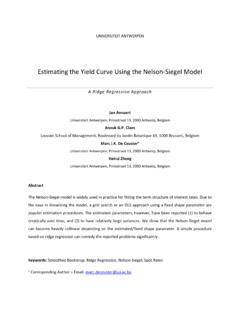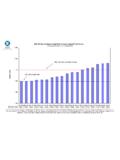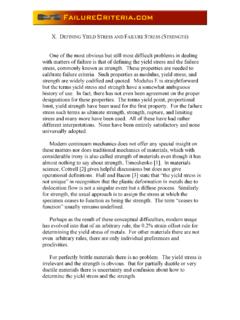Transcription of A Guide to Duration, DV01, and Yield Curve Risk ...
1 A Guide to duration , dv01 , and Yield Curve Risk TransformationsOriginally titled Yield Curve Partial DV01s and Risk Transformations Thomas S. ColemanClose Mountain Advisors LLC20 May 2011 duration and dv01 (dollar duration ) measure price sensitivity andprovide the basic risk measure for bonds, swaps, and other fixed incomeinstruments. When valuing instruments off a Yield Curve , duration andDV01 naturally extend to a vector of partial DV01s or durations (key ratedurations) and these are widely used in the finance industry. But partialDV01s or durations can be measured with respect to different rates:forwards, par rates, zero yields, or others.
2 This paper reviews the conceptsof partial dv01 and duration and then discusses a simple method fortransforming partial DV01s between different rate bases and providesexamples. The benefit of this transformation method is that it onlyrequires calculating the risk of a small set of alternate instrument anddoes not require re-calculating the original portfolio risk. (This paper isalso available in an interactive version with enhanced digital content - seereferences.)Keywords: dv01 , duration , Key Rate duration , Interest Rate Risk, YieldCurve Risk, Dollar duration , Modified duration , Partial dv01 JEL Classifications: G10, G12, E43 PaperIntroductionDuration and dv01 provide the basic measures for evaluating the sensitivity or risk of fixed income instru-ments and are widely used throughout the financial industry.
3 The dv01 (dollar value of an 01) is the deriva-tive of price with respect to Yield :Price=PVHyLDV01=- PV yModified or adjusted duration , the derivative in percentage instead of dollar terms, is the dv01 expressed indifferent units:ModifiedorAdjustedDuration=-100PV PV y=100 dv01 PVOne can use either dv01 or modified duration and the choice between them is largely a matter of conve-nience, taste, and custom. dv01 , also called dollar duration , PV01 (present value of an 01), or BPV (basispoint value), measures the derivative in price terms: the dollar price change per change in Yield . Modifiedduration measures the derivative in percent terms as a semi-elasticity: the percent price change per changein Yield .
4 I will work mostly with dv01 throughout this paper but the ideas apply equally well to modifiedduration. One can use either dv01 or modified duration and the choice between them is largely a matter of conve-nience, taste, and custom. dv01 , also called dollar duration , PV01 (present value of an 01), or BPV (basispoint value), measures the derivative in price terms: the dollar price change per change in Yield . Modifiedduration measures the derivative in percent terms as a semi-elasticity: the percent price change per changein Yield . I will work mostly with dv01 throughout this paper but the ideas apply equally well to modifiedduration.
5 In practice a bond or other fixed-income security will often be valued off a Yield Curve , and we can extend theDV01 and duration to partial DV01s or key rate durations - the partial derivatives with respect to yields fordifferent parts of the Curve :PartialDV01s=J PV y1 PV ykNCalculating and using partial DV01s based on a Curve is a natural extension of the basic Yield dv01 , just aspartial derivatives are a natural extension of the univariate derivative. Partial DV01s of one form or anotherhave been used for years throughout the financial industry (see Ho 1992 and Reitano 1991 for early discus-sions).
6 There is, however, one important difference. For the basic dv01 there is a single, effectively unique, Yield for defining the derivative. Partial DV01s involve a full Yield Curve . Because the Yield Curve can beexpressed in terms of different yields and there is no one best set of yields, partial DV01s can be calculatedwith respect to a variety of possible yields. The values for the partial DV01s will depend on the set of ratesused, even though partial DV01s calculated using alternate yields all measure the same underlying risk. Usingdifferent sets of yields - sensitivity to parts of the Curve - simply measures risk from different perspectives.
7 Sometimes it is more convenient to express partial DV01s using one set of rates, sometimes another. Inpractice it is often necessary to translate or transform from one set of partial DV01s to another. An example will help clarify ideas. Say we have a 10 year zero bond. Say it is trading at $ which is semi-bond Yield . The total dv01 will beDV01sab=- PV ysab= $ is measured here as the price change for a $100 notional bond per 100bp or 1 percentage point change inyield. The modified duration for this bond will be ModD=100 100bpThe modified duration is measured as the percent change in price per 1 percentage point change in Yield .
8 As pointed out above, there is a single Yield -to-maturity for the bond and so little choice in defining the DV01or duration . When we turn to valuation using a Curve , however, there are many choices for the yields used tocalculate the partial DV01s. The exact meaning of parts of the Curve is discussed more [below] [in thecompanion paper], but for now we restrict ourselves to a Curve built with instruments with maturity 1, 2, 5,and 10 years. A natural choice, but by no means the only choice, would be to work with zero-coupon yields ofmaturity 1, 2, 5, and 10 years. Using such a Curve and such rates for our 10 year zero the partial DV01s wouldbe:Table 1 - Partial dv01 ( zero yields) for 10 Year Zero 10-year partial dv01 and the sum of the partial DV01s is the same as the original total dv01 .
9 This shouldnot be a surprise since both the partial dv01 and the original dv01 are calculated using zero yields are a convenient choice for this particular bond but are not the only choice. We could equallywell calculate the risk using yields on par swaps or bonds, shown in table yields are a convenient choice for this particular bond but are not the only choice. We could equallywell calculate the risk using yields on par swaps or bonds, shown in table 2 - Partial dv01 ( par yields) for 10 Year Zero is important to note that in the two examples the exact numbers, both the distribution across the curveand the total (a parallel shift of 100bp in all yields) are different.
10 Nonetheless the risk is the same in partial DV01s are simply expressed in different units or different co-ordinates - essentially transformedfrom one set of rates or instruments to another. Usually we start with risk in one representation or in one basis, often dependent on the particular risk systemwe are using, but then want to use the partial DV01s calculated from another set of yields. We might be giventhe zero-rate partials but wish to see the par- Yield partial DV01s. We would need to transform from the zerobasis to the par basis. This paper describes a simple methodology for transforming between alternate sets of rates or essence of the approach is: Start with partial DV01s (for our security or portfolio) calculated in one representation, usually based on the risk system used and the particular functional form used to build the Curve .





